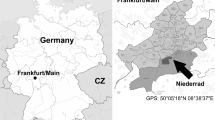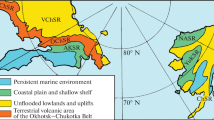Abstract
A new fossil meso-flora consisting of dispersed cuticles has been discovered within the Upper Member of the Middle Triassic (late Anisian) Mukheiris Formation at the eastern rim of the Dead Sea in Jordan. The assemblage consists of a number of different morpho-types of cuticles which can all be assigned to gymnosperms. Cuticles which can be identified as the corystospermalean taxon Dicroidium are fairly abundant and clearly dominate the assemblage, whereas cuticles assignable to other gymnosperms are rather rare. As so far all Triassic records of Dicroidium come from localities at palaeolatitudes above 35°S, these cuticles represent the first record of this genus within the Triassic palaeotropics. Our analysis of this meso-flora suggests that during the late Anisian, as in other regions worldwide, a gymnosperm component of the terrestrial vegetation on the Arabian Peninsula was present. Compared to the palynoflora, which yielded various types of conifer pollen, and pollen of other gymnosperm groups, as well as abundant spores of ferns and lycophytes, the meso-flora is so far lacking a number of plant groups which were present in the source vegetation. It is likely that the differences can be explained by taphonomical biases. The data from cuticles and palynology together prove that either regional terrestrial ecosystems had already recovered, at least to some extent, from the devastating effects of the end-Permian ecological crisis or that these effects were less devastating, at least with regard to vegetation, than assumed by previous studies.







Similar content being viewed by others
References
Abu Hamad, A.M.B. 2004. Palaeobotany and palynostratigraphy of the Permo-Triassic in Jordan. Unpublished Ph.D. Thesis. Germany: University of Hamburg. http://ediss.sub.uni-hamburg.de/volltexte/2005/2309/. Accessed 28 Nov 2018.
Abu Hamad, A.A.B., H. Kerp, B. Vörding, and K. Bandel. 2008. A Late Permian flora with Dicroidium from the Dead Sea Region, Jordan. Review of Palaeobotany and Palynology 149: 85–130.
Abu Hamad, A.M.B., A. Jasper, and D. Uhl. 2012. The record of Triassic charcoal and other evidence for palaeo-wildfires: signal for atmospheric oxygen levels, taphonomic biases or lack of fuel? International Journal of Coal Geology 96(97): 60–71.
Abu Hamad, A.M.B., A. Jasper, and D. Uhl. 2013. Charcoal remains from the Mukheiris Formation of Jordan—the first evidence of palaeowildfire from the Anisian (Middle Triassic) of Gondwana. Jordan Journal of Earth and Environmental Sciences 5: 17–22.
Abu Hamad, A.M.B., A. Jasper, and D. Uhl. 2014. Wood remains from the Late Triassic (Carnian) Abu Ruweis Formation of Jordan and their palaeoenvironmental significance. Journal of African Earth Sciences 95: 168–174.
Abu Hamad, A.M.B., and D. Uhl. 2015. A new macroflora from the Middle Jurassic (Bathonian) of NW Jordan and its palaeoenvironmental significance. Neues Jahrbuch für Geologie und Paläontologie, Abhandlungen 278: 109–122.
Abu Hamad, A.M.B., B. Amireh, H. El Atfy, A. Jasper, and D. Uhl. 2016a. Fire in a Weichselia-dominated coastal ecosystem from the Early Cretaceous (Barremian) of the Kurnub Group in NW Jordan. Cretaceous Research 66: 82–93.
Abu Hamad, A.M.B., B. Amireh, A. Jasper, and D. Uhl. 2016b. New palaeobotanical data from the Jarash Formation (Aptian-Albian, Kurnub Group) of NW Jordan. The Palaeobotanist 65: 19–29.
Abu Hamad, A., P. Blomenkemper, H. Kerp, and B. Bomfleur. 2017. Dicroidium bandelii sp. nov. (corystospermalean foliage) from the Permian of Jordan. PalZ. Paläontologische Zeitschrift 91: 641–648.
Andrews, I. 1992. Permian, Triassic and Jurassic Lithostratigraphy in the Subsurface of Jordan. Subsurface Geology Bulletin 4: 1–60.
Bandel, K., and A.M.B. Abu Hamad. 2013. Permian and Triassic Strata of Jordan. New Mexico Museum of Natural History and Science Bulletin 61: 31–41.
Bandel, K., and H. Khoury. 1981. Lithostratigraphy of the Triassic in Jordan. Facies 4: 1–26.
Barale, G., M. Bamford, B. Gomez, J. Broderick, M.A. Raath, and A. Cadman. 2005. A fossil peat deposit from the Late Triassic (Carnian) of Zimbabwe with preserved cuticle of Pteridospermopsida and Ginkgoales, and its geological setting. Palaeontologica Africana 41: 89–100.
Benton, M.J., and R. Twitchett. 2003. How to kill (almost) all life: The end-Permian extinction event. Trends in Ecology and Evolution 18: 358–365.
Benton, M.J. 2015. When Life Nearly Died: The Greatest Mass Extinction of All Time (Revised edition). London: Thames & Hudson.
Bercovici, A., A. Hadley and U. Villanueva-Amadoz. 2009. Improving depth of field resolution for palynological photomicrography. Palaeontologia Electronica 12(2): 1–12. http://palaeo-electronica.org/2009_2/170/index.html. Accessed 28 Nov 2018.
Bomfleur, B., and H. Kerp. 2010. Dicroidium diversity in the Upper Triassic of north Victoria Land, East Antarctica. Review of Palaeobotany and Palynology 160: 67–101.
Bomfleur, B., P. Blomenkemper, H. Kerp, and S. McLoughlin. 2018. Polar regions of the Mesozoic-Paleogene greenhouse world as refugia for relict plant groups. In Transformative Paleobotany: Papers to Commemorate the Life and Legacy of Thomas N. Taylor, eds. M. Krings, C.J. Harper, R.N. Cúneo, and G.W. Rothwell, 593–611. Amsterdam: Elsevier.
Buratti, N., and S. Cirilli. 2007. Microfloristic provincialism in the Upper Triassic Circum-Mediterranean area and palaeogeographic implication. Geobios 40: 133–142.
Cantrill, D.J., and I. Poole. 2012. The vegetation of Antarctica through geological time. Cambridge: Cambridge University Press.
Cirilli, S., and Y. Eshet. 1991. First discovery of Samaropollenites and the Onslow Microflora in the Upper Triassic of Israel, and its phytogeographic implications. Palaeogeography, Palaeoclimatology, Palaeoecology 85: 207–212.
Erwin, D.H. 2006. Extinction: How Life on Earth Nearly Ended 250 Million Years ago. New Jersey: Princeton University Press.
Fielding, C.R., T.D. Frank, S. McLoughlin, V. Vajda, C. Mays, A.P. Tevyaw, A. Winguth, C. Winguth, R.S. Nicoll, M. Bocking, and J.L. Crowley. 2019. Age and pattern of the southern high-latitude continental end-Permian extinction constrained by multiproxy analysis. Nature Communications 10: 385.
Gastaldo, R.A. 2019. Ancient plants escaped the end-Permian mass extinction. Nature 567: 38–39.
Gastaldo, R.A., R. Adendorff, M. Bamford, C.C. Labandeira, J. Neveling, and H. Sims. 2005. Taphonomic trends of macrofloral assemblages across the Permian-Triassic boundary, Karoo Basin, South Africa. Palaios 20(5): 479–497.
Grauvogel-Stamm, L., and S.R. Ash. 2005. Recovery of the Triassic land flora from the end-Permian life crisis. Comptes Rendus Palevol 4: 525–540.
Kerp, H. 1990. The study of gymnosperms by means of cuticular analysis. Palaios 5: 548–569.
Kerp, H., A.M.B. Abu Hamad, B. Vörding, and K. Bandel. 2006. Typical Triassic Gondwanan floral elements in the Upper Permian of the paleotropics. Geology 34: 265–268.
Kerp, H., and B. Bomfleur. 2011. Photography of plant fossils—new techniques, old tricks. Review of Palaeobotany and Palynology 166: 117–151.
Khalil, B., and S. Muneizel. 1992. Lithostratigraphy of the Jurassic Outcrops of North Jordan (Azab Group). Geological Mapping Division Bulletin 21: 1–50.
Makhlouf, I.M., A. Al-Hiayri, M. Al-Bashish, and H. Abu Azzam. 1996. Sedimentological and lithostratigraphy of the Triassic strata of Jordan at outcrop and in the subsurface. Subsurface Geology Bulletin 7: 1–95.
Makhlouf, I.M. 2003. Fluvial/tidal interaction at the southern Tethyan strandline during Triassic Mukheiris times in central Jordan. Journal of Asian Earth Sciences 21: 377–385.
Makhlouf, I.M. 2006. Late Triassic-Early Jurassic Neotethyan evolution at Northern Gondwana (Jordan and Lybia, Mediterranean region). Geologica Acta 4: 371–376.
NCJSC (Nomenclature Committee for the Jordanian Stratigraphic Column). 2000. Nomenclature Committee for the Jordanian Stratigraphic Column, Part 2—Internal Report of the Jordan Natural Resources Authority, 1–46. Amman: NRA.
Niklas, K.J. 1985. The aerodynamics of wind pollination. The Botanical Review 52: 328–386.
Nowak, H., E. Schneebeli-Hermann, and E. Kustatscher. 2019. No mass extinction for land plants at the Permian-Triassic transition. Nature Communications 10: 384.
Rees, P.M. 2002. Land-plant diversity and the end-Permian mass extinction. Geology 30: 827–830.
Sadeddin, W. 1990. Pseudofurnishius priscus n. sp. (Conodonta) and its stratigraphical significance for the Ladinian (Middle Triassic) in Jordan. Neues Jahrbuch für Geologie und Paläontologie, Abhandlungen 178(3): 369–382.
Sadeddin, W. 1992. Acanthotheelia jordanica n. sp., a new holothurian sclerite species from the Pelsonian (Middle Anisian) of Jordan. Revista Española de Micropaleontologia 23(2): 83–88.
Sadeddin, W. 1995. Holothurian sclerites from the Triassic of Jordan and their stratigraphic importance. Journal of Micropalaeontology 15: 83–95.
Sadeddin, W. 1998. Conodont-biostratigraphy, and paleogeography of the Triassic in Jordan. Palaeontographica (A: Paläozoologie, Stratigraphie) 248: 119–144.
Sadeddin, W., and H. Kozur. 1992. Pseudofurnishius siyalaensis n. sp. (Conodonta) from the Lower Ladinian of Wadi Siyala (Jordan). Neues Jahrbuch für Geologie und Paläontologie, Monatshefte 1992(6): 359–368.
Schoch, R.R. 2011. A new stereospondyl from the Middle Triassic of Jordan. Fossil Record 14: 119–127.
Scotese, C.R. 2002. Paleomap Project. http://www.scotese.com. Accessed 28 Nov 2018.
Shawabekeh, K. 1998. The Geology of Ma’in Area-Map Sheet No. (3155 III) Hashemite Kingdom of Jordan, National Resources Authority-Geol. Geological Mapping Division Bulletin 40: 1–74.
Taylor, T.N., E.L. Taylor, and M. Krings. 2009. Paleobotany: the biology and evolution of fossil plants. Amsterdam: Elsevier.
Traverse, A. 2007. Paleopalynology, 2nd ed. Amsterdam: Springer.
Uhl, D., A. Jasper, T. Schindler, and M. Wuttke. 2010. Evidence of paleowildfire in the early Middle Triassic (early Anisian) Voltzia Sandstone: the oldest post-Permian macroscopic evidence of wildfire discovered so far. Palaios 25(12): 837–842.
Acknowledgements
The authors thank the guest-editors for the opportunity to contribute to this special issue in honour of Hans Kerp. Furthermore, we gratefully acknowledge funding by the Deutsche Forschungsgemeinschaft (UH 122/3-1 and UH 122/5-1), as well as the University of Jordan (Amman/Jordan) for logistic support during field work. A. Jasper acknowledges additional financial support by CNPq (Brazil-305436/2015-5) and the Alexander von Humboldt Foundation (Germany). We thank Christian Pott and an anonymous reviewer, as well as guest editor Benjamin Bomfleur and editor-in-chief Mike Reich for useful comments that helped to improve the manuscript.
Author information
Authors and Affiliations
Corresponding author
Additional information
Handling Editor: Benjamin Bomfleur.
Rights and permissions
About this article
Cite this article
Abu Hamad, A.M.B., Al-Saqarat, B., Gonçalves, C.V. et al. The first record of Dicroidium from the Triassic palaeotropics based on dispersed cuticles from the Anisian Mukheiris Formation of Jordan. PalZ 93, 487–498 (2019). https://doi.org/10.1007/s12542-019-00470-1
Received:
Accepted:
Published:
Issue Date:
DOI: https://doi.org/10.1007/s12542-019-00470-1




